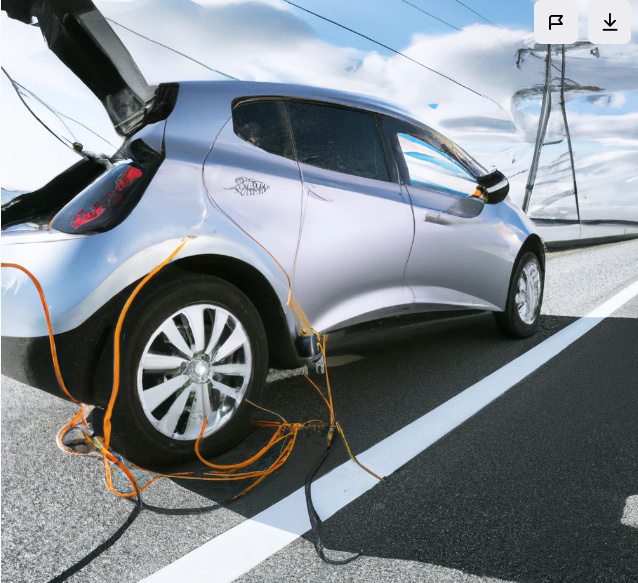Electric cars can lose over one third of the electricity just during charging, depending on the model.

AI generated image
Germany’s online Blackout News here reports: “Charging losses for electric cars ranges from 9.8% to 38.2%, depending on the model.”
That means, on some models, nearly one third of the electricity to charge a lithium-ion HV battery gets lost. When charging, the “current flows against the internal resistance of the battery, generates heat and is lost.”
Higher costs, time wasted
Losses occur when AC current gets converted to DC, but also in the cables and connections. “These losses have a direct impact on charging time and costs. A 20 percent loss means a 20 percent longer charging time and 20 percent higher costs,” reports Blackout News.
Loss ranges from 9.8% to 38.2%
The Kia e-Soul models has the lowest losses of the cars tested, only 9.8%. Tesla’s Model Y Long Range saw 14.8% of the electricity for charging end up being lost.
The worst performing – losing more than quarter of the electricity – were Polestar 2 78 kWh AWD (27%), Smart EQ fortwo (29.2%), and the Renault Zoe Z.E. 50 E-Tech (31.1%).
Renault Twingo ZE loses 38%!
The worst was the Renault Twingo ZE with a whopping 38.2% of the charge getting lost. Data Source: Praxis Elektroauto
The efficiency was determined by calculating what was put in and what actually came out.
As a comparison, to get idea how bad the problem is, imagine spilling one third of the gasoline or diesel while filling your internal combustion engine vehicle. That’s expensive and a real waste.
During DC charging, there are only between 5 and 10 percent losses, depending on the charging power and battery system.
See entire article here (German)





[…] blog of the day is No Tricks Zone, with a post on how much power is lost when charging an […]
“Losses occur when AC current gets converted to DC,
but also in the cables and connections.”
Asking for a friend:
What does the above mean in physical terms. Surely electrons
do not trickle out onto the ground. Where do they go? Heat?
“The positron or antielectron is the particle with an electric charge of +1e, a spin of 1/2, and the same mass as an electron. It is the antiparticle of the electron. When a positron collides with an electron, annihilation occurs. If this collision occurs at low energies, it results in the production of two or more photons.” [Wikipedia]
The general concept is that any conversion of energy into another is lossy, and the loss is often generated heat. So from the wall socket to the battery to the engine (and in broader scope, from mining the coal to heating water with it to run steam turbines to get transformed up to 400KV, then down to 20KV then 240V), each time power runs through transformers made of copper wires, which are electrical and inductive resistors, where energy does waste work and turns into heat. Then in the battery/accumulator, chemical reactions have to happen to shift ions around which causes heat again.
Here is an article on the losses during the charging:
https://go-e.com/en/magazine/ev-charging-losses
The total losses from coal or oil to the battery have been calculated here:
https://insideenergy.org/2015/11/06/lost-in-transmission-how-much-electricity-disappears-between-a-power-plant-and-your-plug/
What it means is that the author presented numbers with no context. The higher the battery voltage, the lower the current required; however, if the car battery voltage is higher than the charger voltage, then a dc/dc transformer in the car has to convert the lower voltage/higher current it recieves from the charger to higher voltage/lower current to charge the battery. This conversion is what causes newer, higher-voltage batteries to be less efficient when charging from lower-voltage sources.
Of course the author didn’t explain this because the author probably doesn’t understand this, but still thinks that they sound authoritative.
Yet, energy is lost in the all process. Physics cannot be fooled.
However any process that goes from energy to work has losses.
Tisnt the electrons that get ‘lost’, it’s the energy in the field flux that is dissipated.
[…] Image: Green Inefficiency: Up To One Third Of Power Needed To Charge Up E-Car Battery Gets Lost! […]
I can count on this website to demonize EVs and claim CO2 does little or nothing.
This article is old news and irrelevant. It is spun to criticize EVs for doing what all EVs have always done, first measured over a decade ago. There is an efficiency loss of 10% to 20% in converting household AC to DC in an EV battery and back to AC for the EV electric motor.
Including that efficiency loss, EVs are cheaper to run (fuel cost only) than ICEs. The main reason is the huge efficiency loss of gasoline powered engines, which lose up to 75% efficiency as heat loss, making EV efficiency looses look relatively small. But why ruin a good scare story with that ICE fact?
EVs have a huge list of problems and disadvantages. Starting with high cost, fast depreciation, low reliability, lower range in cold weather and inconvenient time consuming refueling. There is no need to lie or exaggerate to criticize them. This article is deliberately deceptive and biased, by reporting a well known fact about EVs s if it is new bad news.
Study on the subject from 2016
https://www.sciencedirect.com/science/article/pii/S0360544217303730
[…] No Trick Zone […]